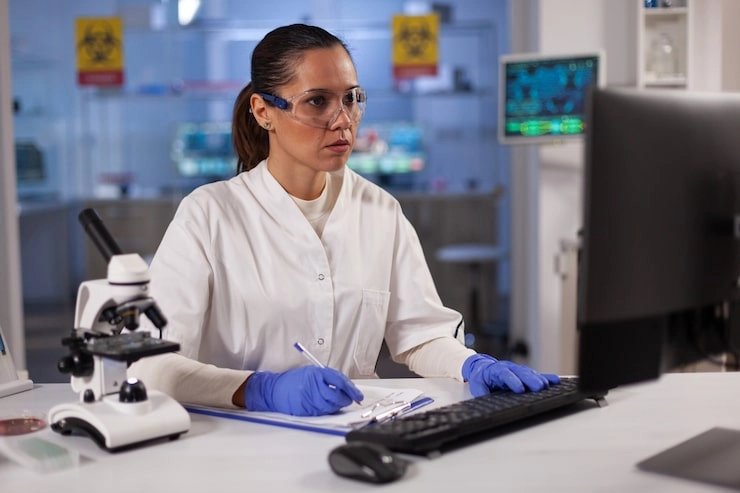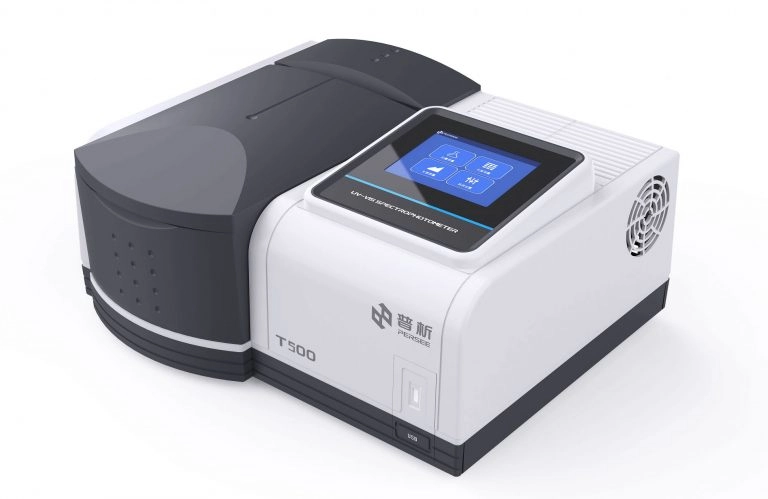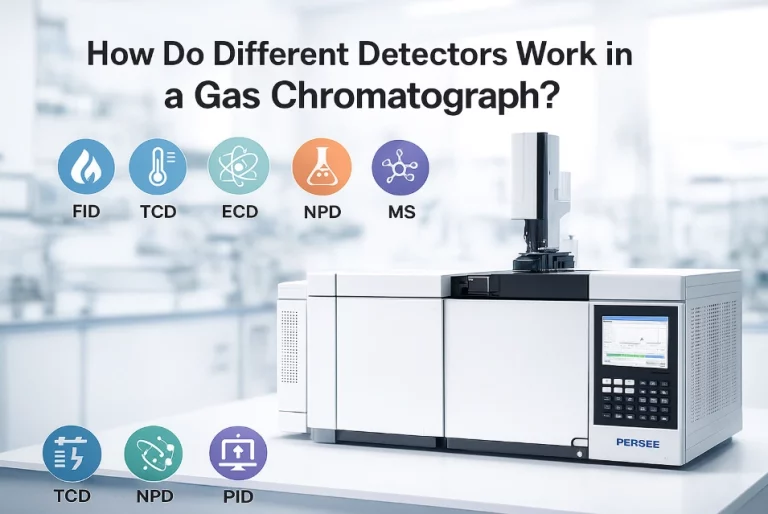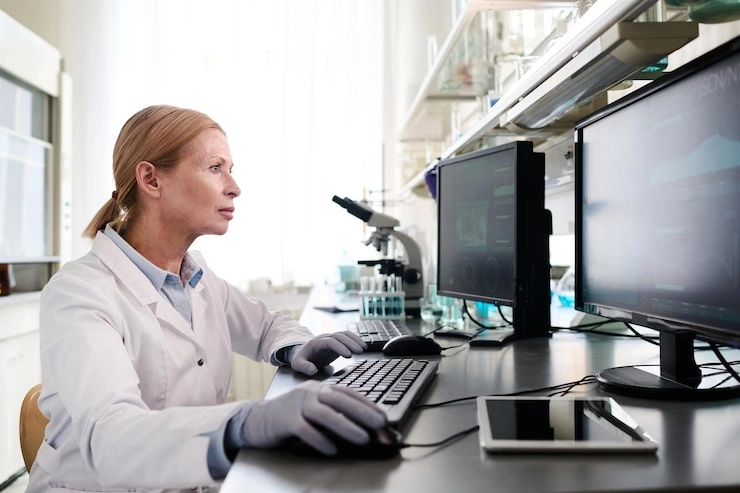
Finding tiny amounts of substances in complex mixtures is a key part of today’s science. This important work, known as trace analysis, helps us find and measure extremely small concentrations of things in difficult materials. It’s a very big deal. For example, we need it to check for pollution in the environment, make sure our food is safe, and confirm that medicines are pure. The ability to correctly spot these trace components is absolutely essential. Many tools can do this, but the triple quadrupole mass spectrometer really is the best one for this tough job. It has amazing sensitivity, selectivity, and precision for measuring amounts, making it the perfect instrument for finding things at trace levels.
The Principles Behind Triple Quadrupole Mass Spectrometry
To understand why a triple quadrupole mass spectrometer is so good at trace analysis, we should first look at the basic technology behind it.
What is a Quadrupole Mass Analyzer?
A quadrupole mass analyzer is a kind of mass filter. It uses changing electric fields to guide ions along a path based on their mass-to-charge (m/z) ratio. It’s made of four parallel rods set up in a square shape. By changing the electricity applied to these rods, only ions with certain m/z values can get through to the detector. All the others are filtered out. This basic idea allows for very careful selection and filtering of ions.
How a Triple Quadrupole System Operates
A triple quadrupole mass spectrometer, or QqQ for short, uses three quadrupoles one after another. The first one (Q1) and the third one (Q3) work as mass filters. The middle one (q2), however, is a collision cell.
Here’s how it works in practice:
- First of all, Q1 picks out the “precursor ion.” This is usually the whole molecule being studied, and it’s chosen by its unique m/z ratio.
- Next, q2 causes the ion to break apart. It does this by adding a neutral gas, like argon. When the precursor ions hit the gas molecules, they shatter into smaller, predictable “product ions.” This process is called Collision-Induced Dissociation (CID).
- Lastly, Q3 looks for or picks out certain product ions to be detected.
This series of steps allows the machine to aim for and study specific compounds with great accuracy, even when they are mixed in with many other substances.
Key Components and Their Functions
Each part has a very important job:
- Q1: It separates the main parent ion from all other ions made in the source.
- q2: This part breaks the chosen parent ion into smaller product ions that we can predict.
- Q3: It then separates out a single, specific product ion. This confirms what the original molecule was and gives a very clean signal for measurement.
The way these parts work together supports powerful methods like Multiple Reaction Monitoring (MRM). What’s more, MRM gives incredible sensitivity and specificity.
Advantages of Triple Quadrupole Mass Spectrometers in Trace Analysis
The triple quadrupole system has a few clear benefits that make it really good for trace analysis in complicated mixtures.
High Sensitivity for Low-Level Detection
A huge reason to use a triple quadrupole system is its fantastic sensitivity. It is so sensitive. It can spot analytes at parts-per-trillion (ppt) levels, and sometimes even lower. This makes it perfect for jobs where even the smallest amounts are important, like finding pesticide residues, drug metabolites, or pollutants that stay in the environment for a long time.
Exceptional Selectivity to Overcome the Matrix Effect
When working with real-world samples like soil, blood, or food, scientists have a big problem called the “matrix effect.” This happens when other things in the sample mess with the target analyte’s signal, either making it weaker or stronger. As a result, this can ruin the accuracy of the measurement.
The MRM mode is powerful because it filters the ions twice. Q1 is the first gate, only letting the precursor ion through. After the ion breaks apart in q2, Q3 acts as a second gate. It only lets a specific, known product ion get to the detector. This very specific “precursor-to-product” ion pathway is like a unique fingerprint for the target compound. So, this two-step filtering greatly cuts down on background noise. It practically gets rid of interference from the sample matrix. Thus, it ensures a clear and correct signal, even for tiny amounts of a substance.
Quantitative Accuracy Across a Broad Dynamic Range
Triple quadrupole systems provide strong and dependable measurements across a very wide range of concentrations. This means they can accurately measure both low-level (trace) and high-level compounds in the same test. This is a priceless feature when samples have a wide variety of components.
Application Areas Requiring Trace Analysis in Complex Samples
The usefulness of triple quadrupole mass spectrometers is seen in many industries where finding trace-level substances is absolutely necessary.
- Environmental Monitoring and Contaminant Detection: Checking the quality of air, water, and soil often means we have to find pollutants at very low levels. A triple quadrupole mass spectrometer helps meet government rules by identifying things like heavy metals, pesticides, and endocrine disruptors with great certainty.
- Food Safety and Residue Analysis: To keep food safe, we must find banned things like animal drugs, mycotoxins, or leftover pesticides. The selectivity of MRM lets scientists find these substances even inside complex food materials like milk, meat, or fruit extracts.
- Clinical and Biomedical Research: In drug or toxicology studies, scientists need to measure biomarkers or drug byproducts that are at very low levels in body fluids. The precision of triple quadrupole systems gives trustworthy data for making clinical choices and research findings.
- Pharmaceutical Quality Control: Making medicines requires strict testing to check for product purity and the right dosage. Triple quadrupole machines help find impurities or breakdown products that might change how well a drug works or if it is safe.
Comparison with Other Mass Spectrometry Techniques
Other MS tools are used for analysis, but they are very different from triple quadrupoles when it comes to trace analysis.
- Single Quadrupole vs. Triple Quadrupole Systems: Single quadrupoles just can’t do tandem (MS/MS) analysis. They can’t perform fragmentation methods like MRM. Because of this, they are much less selective and are more affected by matrix interference. This makes them not as good for complex samples when you compare them to triple quadrupoles.
- Time-of-Flight (TOF) vs. Triple Quadrupole Performance: Time-of-Flight (TOF) machines, especially high-resolution ones like Q-TOFs, are great at full-scan analysis. They give very precise mass readings, which are needed to identify unknown compounds. But, for measuring known substances at super-low levels, the triple quadrupole’s MRM mode usually provides lower detection limits. It also has a wider dynamic range and is tougher against bad matrix effects.
- When to Choose a Triple Quadrupole Over Other Technologies: If your work requires the absolute best sensitivity and selectivity for measuring tiny amounts of specific compounds in complex materials—like for regulatory testing or clinical diagnostics—a triple quadrupole system is the clear winner. Its performance in MRM mode is just unmatched.
Workflow Efficiency and Operational Benefits
Besides their analytical power, triple quadrupoles also make lab work more efficient.
- Simplified Sample Preparation with Enhanced Selectivity: The amazing selectivity from MRM means that samples often don’t need as much cleanup. Sometimes, difficult and long processes like solid-phase extraction (SPE) can be swapped for simple “Dilute-and-Shoot” methods. This does not just save a lot of time and uses less solvent. It also lowers the chance of losing or contaminating the analyte during sample prep.
- Reduced Matrix Interference and Background Noise: The machine focuses only on specific ion pathways instead of scanning a wide mass range. By doing this, chemical noise is cut down a lot. This gives you cleaner results, makes it easier to find the right peaks, and creates higher signal-to-noise ratios.
- Compatibility with Chromatographic Techniques (GC/MS, LC/MS): Triple quadrupoles connect easily with both gas chromatography (GC) and liquid chromatography (LC). This gives you the freedom to create the best methods for a huge variety of different analytes.
Technological Innovations Enhancing Triple Quadrupole Performance
New developments have made triple quadrupoles even more important as necessary tools.
- Collision-Induced Dissociation (CID) Capabilities: Today’s CID cells are very efficient. They ensure strong and repeatable fragmentation. This helps confirm a compound’s identity with a high degree of confidence, even when telling the difference between very similar molecules.
- Multiple Reaction Monitoring (MRM): MRM is still the top method for targeted measurement. It has changed the field by tracking unique precursor-product ion pairs. The result is a big improvement in both sensitivity and specificity.
- Software Integration for Data Processing and Reporting: Modern systems have easy-to-use software that handles many tasks automatically. For instance, it can set up methods, integrate peaks, create calibration curves, and format reports. This makes getting and understanding data faster, more dependable, and with less chance for human mistakes.
PERSEE: A Trusted Manufacturer of Analytical Instruments
Since the benefits of triple quadrupole mass spectrometry are clear, picking a dependable and advanced instrument maker is very important. This choice affects not just what you can do analytically but also your long-term support and ability to develop new applications.
Overview of PERSEE’s Expertise in Scientific Instrumentation
PERSEE has been a major player in scientific instruments since it was started over 60 years ago. With many decades of knowledge in areas from optical spectroscopy to chromatography-mass spectrometry, PERSEE keeps making new products designed for the changing needs of labs around the world.
Highlighting PERSEE’s G5 GC-MS/MS System for Advanced Trace Detection

PERSEE’s G5 GC-MS/MS system is a perfect example of the technical benefits we’ve talked about. Its modern electron ionization (EI) source is designed for high efficiency. Smart temperature controls also keep it running steady for long periods. This is a key feature for busy labs testing for environmental or food safety. Additionally, its improved two-stage vacuum design helps more ions get through, which is a big deal for reaching the ppt-level detection needed for trace analysis in complex materials.
Commitment to Quality, Support, and Innovation
PERSEE’s systems meet CE certification standards. The company has technical support teams all over the world, and its software comes in multiple languages. So, PERSEE is dedicated not just to how well its instruments work, but also to making sure users are happy from the day of installation through everyday use. They are always investing in research and development, which makes sure their instruments stay at the cutting edge of analytical technology.
FAQs:
Q1: What makes a triple quadrupole better than other types of mass spectrometers for trace analysis?
A: A triple quadrupole mass spectrometer is better because it has excellent sensitivity and selectivity. This is due to its special ability to do Multiple Reaction Monitoring (MRM). This “dual-mass filtering” method zeroes in on a specific precursor ion and a specific product ion. By doing so, it greatly lowers background noise and matrix effects from complex samples. This makes it the perfect tool for getting the lowest detection limits in targeted measurement jobs, beating the usual performance of single quadrupole or TOF systems for this specific use.
Q2: Can I use a triple quadrupole system for both qualitative and quantitative analysis?
A: Yes, you can. It’s mainly built for top-notch quantitative work using targeted methods like MRM. However, a triple quadrupole can also be used for qualitative identification. It can do product ion scans to create fragmentation patterns (spectra) from a chosen precursor ion. This gives useful structural details to help identify unknown or surprising compounds.
Q3: Is PERSEE’s G5 GC-MS/MS suitable for routine lab use?
A: Yes, it is. The PERSEE G5 GC-MS/MS is made for the daily work of a regular analytical lab. It has automatic tuning, a strong vacuum system made for long-term, stable use with little upkeep, and a simple software interface that makes it easy to develop methods and run daily operations. These features make it a great pick for places like environmental monitoring or pharmaceutical QC labs that need steady, trustworthy performance every single day.










